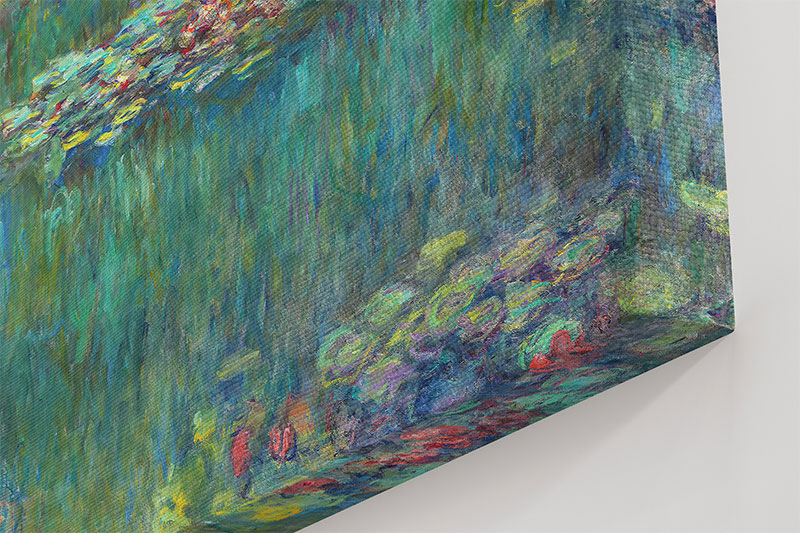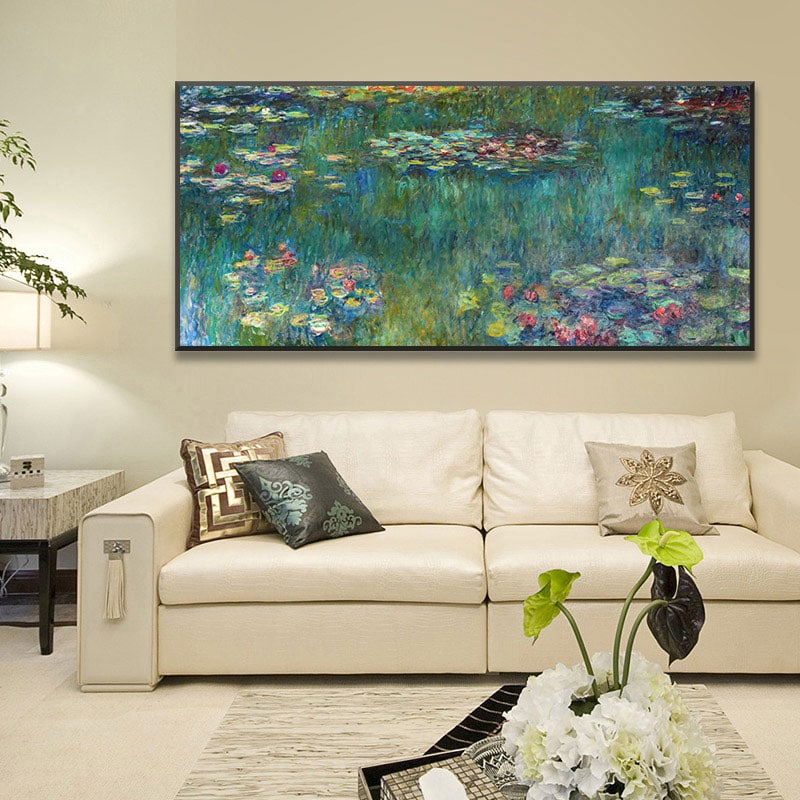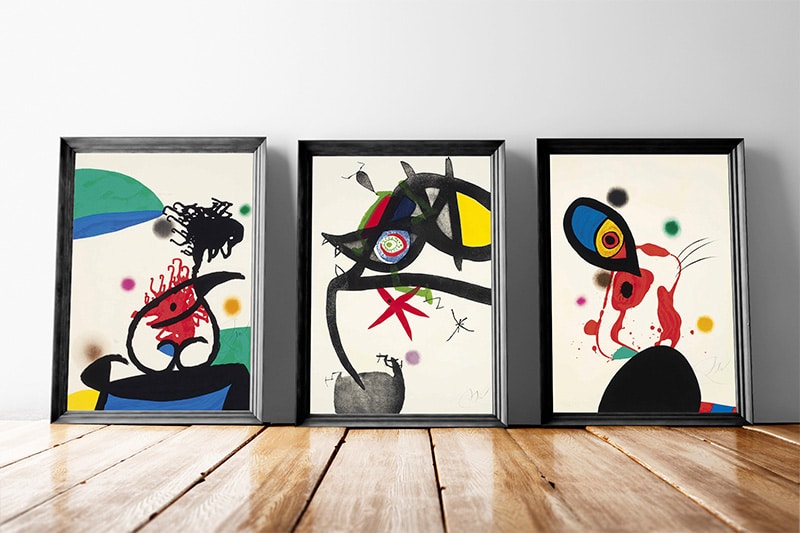- How to frame a rolled canvas print
- Choose between three different ways of presenting your canvas art:
How to frame a rolled canvas print
Ready-mounted canvases loosen overtime and are easily damaged when shipping. Therefore, buying rolled canvases and having them freshly stretched is highly beneficial, evading the risk of damage, sagging, and the wear and tear when moving. To frame canvas paintings might seem to be a daunting task. How to frame a rolled canvas print? It is easier than you might think! Numerous online framing stores offer affordable services. Read on if you want to get your picture perfectly taut yourself.
Choose between three different ways of presenting your canvas art:
- You can frame a canvas print by mounting your picture on a wooden stretcher frame and present it exposing the edges.
- A float frame for canvas art enhances a piece after stretching for a professional museum look.
- You can frame canvas paintings by directly putting the canvas behind a glass frame for extra dust protection.
Let’s look at each of these three options for framing canvas paintings separately.
1. Mounting canvas art prints on a wooden stretcher frame
The most convenient way for framing canvas paintings is to buy a ready-assembled wooden stretcher frame or separate wooden stretcher bars, which are available at any good art supply or craft store. Both options require the use of “keys” – small triangle-shaped wedges that are inserted in the joint edges to give the canvas the appropriate degree of tension after stretching. When fastening, it is important to equally distribute the tension across the entire frame, which will avoid later warping of the canvas.

Place your canvas face down on a clean surface and fold the extra canvas over the stretcher-bar. Pigment Pool’s canvases have an extra 6 cm space along all the edges, making stretching easy. Use a staple gun to secure the canvas fabric to the back of the frame keeping regular spacings along all sides. Fold the corners by tucking one side under the other while pulling tightly. Once your picture is optimally stretched, use a pair of scissors or a scalpel to cut off any spare fabric.
You can directly mount your stretched canvas paintingPainting is a fundamental form of visual art that has been practiced for thousands of years. It involves applying pigment to a surface such as canvas, paper, or a wall. Painting can be explored through various styles, techniques, and mediums, each offering unique possibilities for expression and creativity. Historical Background • Ancient Beginnings: The history of painting dates back to More on the wall, exposing the edges for a contemporary look. If you wish to add a frame, proceed to step 2) or 3).
2. Float frame for canvas artwork
With the so-called float frame for canvas artwork, the edges of your stretched canvas will remain visible in the gap between the stretcher bar and the frame, exposing the artwork fully to the viewer. It will create the illusion that the artwork is floating unsupported inside, giving the art a recessed perspective.

When framing your stretched artwork, make sure that the rabbet of the frame (also called “groove”) is larger than the thickness of the stretcher bar, so that the canvas will fit within it. A float frame for canvas artwork is attached to the canvas from the backside as opposed to the traditional framing with a lip on the front as described in the following paragraph. If the rabbet is much deeper than the stretcher bar, you can make adjustments using picture frame points at the required depth.
3. Framing stretched canvas behind glass
You can frame a canvas print behind glass in a wood or metal picture frame to keep it from getting dusty. As with a floating frame, make sure to select a frame with a rabbet deep enough for the stretcher bar. It is possible to switch the offset clips of your frame around, leaving the back open and have the back of the canvas be the back of the framed piece. Make sure that the paintingPainting is a fundamental form of visual art that has been practiced for thousands of years. It involves applying pigment to a surface such as canvas, paper, or a wall. Painting can be explored through various styles, techniques, and mediums, each offering unique possibilities for expression and creativity. Historical Background • Ancient Beginnings: The history of painting dates back to More does not touch the glass.

Choosing the right picture frame does not only protect your artwork and makes displaying safer and easier. Whether framing a canvas art print trough bare stretching, in a float frame for canvas artwork, or behind glass, it will also set your picture apart from its surroundings and aesthetically enhance it.
Framing for Different Room Lighting
When selecting a frame, it’s essential to consider how room lighting—natural or artificial—will interact with the materials and finish of the frame. In rooms flooded with natural light, matte or wooden frames are ideal as they reduce glare and create a warm, subtle aesthetic without distracting reflections. Metallic or glossy frames, while sleek, can reflect light harshly in bright spaces, so they’re better suited for rooms with softer, indirect lighting.
In spaces dominated by artificial lighting, the intensityIn color theory, intensity, also known as saturation or chroma, refers to the purity and vividness of a color. This property is essential for artists and designers as it helps create dynamic and engaging visuals. Intensity determines how bright or dull a color appears, influencing the overall impact and mood of a composition. Defining Intensity Intensity measures the degree of More and color temperature of the light affect how the frame looks. Cooler lighting pairs well with darker or neutral-toned frames, as these materials won’t compete with the artwork. Conversely, in warm artificial lighting, rich wooden or textured frames can enhance the artwork’s depth. Additionally, using UV-resistant glass can protect your artwork from light damage, preserving both the frame and the art.
You might also be interested in the following posts by Pigment Pool:
The Art of Hanging Art: How to Follow and Break Rules
Literature for Artists and Art Enthusiasts – 16 Essential Books on Modern Art 2021
What frame styles work best in low-light rooms?
In low-light rooms, frames with lighter finishes, such as white or light wood, help brighten the space. They create contrast against dim surroundings and draw attention to the artwork. Matte finishes also minimize reflections from artificial lighting.
How can I protect framed canvas art from UV damage?
UV-resistant glass or acrylic can protect canvas prints from fading due to sunlight exposure. These materials block harmful UV rays while maintaining clarity. Additionally, placing art away from direct sunlight can prolong its vibrancy.
Can I frame a textured canvas?
Yes, textured canvases benefit from floating frames, which provide a gap between the artwork and the frame, emphasizing the texture. Deep-set frames can also accommodate the added depth without compressing the canvas. Avoid glass for heavily textured pieces to maintain their three-dimensional effect.
How does room temperature affect framed artwork?
Extreme temperature fluctuations can cause frame materials to expand and contract, potentially damaging both the frame and the canvas. Keeping your artwork in a climate-controlled environment helps preserve its integrity. Materials like wood are more susceptible to warping, so consider metal frames for rooms prone to temperature changes.
What is the benefit of using a floating frame for canvas prints?
Floating frames create a visual effect where the artwork appears suspended within the frame, adding a professional, gallery-like look. They are ideal for modern or minimalist spaces and work especially well with textured canvases. The gap around the canvas highlights the depth of the artwork.
How do I choose a frame finish based on wall color?
For light-colored walls, darker frames create contrast and help the artwork stand out. Conversely, light or neutral frames blend well with darker walls, offering a more subtle look. Choosing complementary colors ensures harmony between the wall, frame, and artwork.
Should I add a mat when framing a canvas print?
While mats are typically used for paper prints, they are less common for canvas due to the canvas’s thickness. However, mats can be used creatively to add contrast or focus to a piece. If using a mat, make sure it enhances the artwork without overwhelming it.
How do I hang large framed canvas prints securely?
For large, heavy frames, use wall anchors or picture-hanging hardware rated for the weight of the piece. Two hooks spaced apart can help distribute the weight evenly and prevent tilting. Always check that the wall can support the weight, especially if you’re hanging it on drywall.
What is the best frame material for high-humidity rooms?
Metal or composite frames are more resistant to warping in high-humidity environments like bathrooms. Wood frames can expand or contract with moisture, causing damage over time. Sealing the artwork and frame can offer additional protection against moisture.
Can I frame a canvas with a glass cover?
While glass is typically used for paper art, it can also be used for canvases to protect against dust and environmental damage. However, many prefer to leave canvases uncovered to showcase their texture. If you choose glass, ensure there’s enough space between the canvas and the glass to avoid compression.
